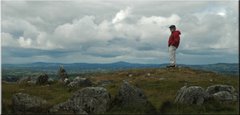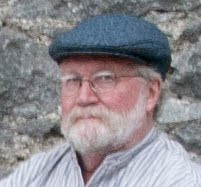 The first Infinium-S in operation outside Japan, April 20, 2007, DeAnza College, Cupertino, California
The first Infinium-S in operation outside Japan, April 20, 2007, DeAnza College, Cupertino, CaliforniaToday marked the first (well, sort of) "official" use of the new planetarium projector: an initial training session for those of us who will be operating it by the Konica-Minolta staff. Installation and fine-tuning of the device is very nearly finished, and training in its use, programming, and upkeep will continue over the next four days.
 Initial gathering at the control console.
Initial gathering at the control console.I should note that the photos in this post are not quite of the quality that I've tried to maintain in this blog, and with good reason. Even in the lighted portions of the training, the ambient light in the planetarium dome was very dim. Not wanting to use flash, that meant long exposure times and noise-ish images. Still, better views can be had by clicking on any image.
 View from the front of the theater toward the control area at rear.
View from the front of the theater toward the control area at rear.The image above really has to be seen at larger size (by clicking on it) to appreciate. It shows the projector (at right) in operation. It was being turned as the exposure was made, and star trails can be seen on the dome.
 Ken Hawthorn (Community Ed) and Marek Cichanski (Geology faculty) work the controls.
Ken Hawthorn (Community Ed) and Marek Cichanski (Geology faculty) work the controls.It is hard to convey in words or pictures how realistic (and awe-inspiring) the sky that's provided by the Infinium-S system is. Star images are sharp and tiny, the Milky Way is simulated by a quarter of a million individual points of light, the 21 brightest stars can be made to scintillate (twinkle) realistically, and many "deep sky" objects -- galaxies and star clusters -- are rendered sufficiently accurately that viewing them through binoculars isn't a thoroughly ludicrous thing to do.
By looking closely at star images at the horizon, I estimate that the largest of them are about an eighth of an inch across. As seen from a typical audience member's distance, about 30 feet, an eighth of an inch subtends an angle of about 1 1/4 arcminutes, which is close to normal human eyesight limiting resolution. It's also three to four times finer resolution than we had with the previous projector.
 Ken Hawthorn on the flight deck.
Ken Hawthorn on the flight deck.Computer control of virtually every aspect of the sky simulation allows not only a greater range of WOW stuff (as it's called in the specialized technical jargon of planetaria), but also a smaller control console. The controls for the old MS-15 took up five times this much space, easily.
 Trainees and their trainers on April 20th.
Trainees and their trainers on April 20th.Our trainers today from Konica-Minolta were Shu (kneeling) and Ume (at far right). The nine trainees were from the DeAnza faculty and Community Education's planetarium staff. The planetarium facility is operated by Community Ed, but College classes are held in it for seven hours per day, Mondays through Thursdays. It's a remarkably amicable symbiosis between two very much administratively separate arms of the College.
The two men in this picture who live in the Santa Cruz Mountains -- Planetarium Director Karl von Ahnen and I -- are the ones with the beards. I'm the one with hair on top of my head, too.
There is something of an aberration about this picture, by the way. Notice that, aside from our Japanese trainers, everybody else in the picture is a white male. This is highly unusual for DeAnza, and I'm not quite sure why the group worked out this way (I hadn't noticed until I just now put the picture into the draft of this post.) It warrants some thought, but I don't think it really amounts to anything more than small-number statistics. Our "bosses" (the Deans of Physical Science and of Community Ed) are both women, for example, and their bosses (at the VP level) are, as well. To see a more typical-looking group at DeAnza, take a look at this little slide show of my Division's March meeting.
 Cooper expresses his opinion of the quality of the translation.
Cooper expresses his opinion of the quality of the translation.Previous posts about the Planetarium renovation:
My God, It's Full of Seats!
and
Giddy with Anticipation



2 comments:
You got a public session schedule for that thing? I'd go out of my way to see it during one of my infrequent trips to family in San Jose....
Thanks as always for the great post. Your excitement is infectious.
Community Ed is planning a gala, official "grand opening" for public sessions sometime in the Fall. The Infinium-S is a great piece, but only one piece, of the project, and there are other goodies still to be installed -- all-sky video and an upgraded audio system among them -- so it's not ready for much besides school use at the moment.
But you can be sure I'll let you know when it's time!
Post a Comment